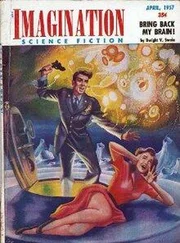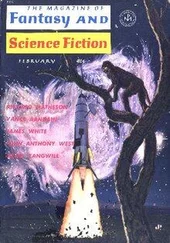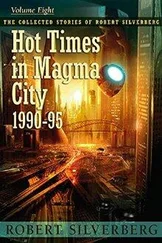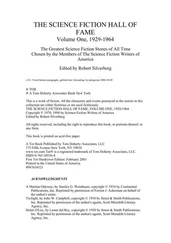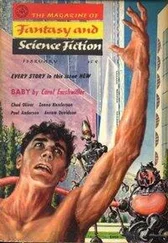Lombroso, calm to the point of seeming patronizing, drifted easily across his majestic office and stared a moment into his showcase of medieval treasures. At length he said, speaking with his back turned, “You’re being excessively melodramatic, Lew. The world is full of people who frequently make lucky guesses. You’re one yourself. He’s luckier than most, sure, but that doesn’t mean he can see the future.”
“All right, Bob.”
“Does it? When you come to me and say the probability of an unfavorable public response to this or that piece of legislation is thus-and-such, are you seeing into the future, or just taking a guess? I never heard you claim clairvoyance, Lew. And Carvajal—”
"All right!"
“Easy, man.”
“I’m sorry.”
“Can I get you a drink?”
“I’d like to change the subject,” I said.
“What would you like to talk about next?”
“Oil gellation policy.”
He nodded blandly. “The City Council,” he said, “has had a bill in committee all spring that calls for gellation of all oil aboard tankers coming into New York Harbor. Environmentalists are for it, naturally, and, naturally, the oil companies are against it. Consumer groups aren’t too happy about it because the bill is bound to push up refining costs, which means retail price increases. And—”
“Don’t tankers carry gelling equipment already?”
“They do, yes. Been a federal regulation since, oh, ‘83 or so. The year they first began the heavy offshore pumping in the Atlantic. Whenever a tanker has an accident that causes structural rupture and there’s a chance of an oil spill, a nozzle system sprays all the crude in the damaged section with gelling agents that turn the oil into a solid glob, right? Which keeps the oil inside the tank, and even if the ship breaks up altogether the gelled oil floats in big chunks that can easily be scooped up. Then they simply have to heat the gel to — what is it, 130 degrees Fahrenheit? — and it turns back into oil. But it takes three or four hours just to spray the stuff into one of those huge tanks, and another seven or eight for the oil to gel, so we have a period of maybe twelve hours following the onset of gellation in which the oil is still fluid, and a lot of oil can escape in twelve hours. So City Councilman Ladrone has this plan requiring oil to be gelled as a routine step in transporting it by sea to refineries, not just as an emergency response in case a tanker cracks open. But the political problems are—”
“Do it,” I said.
“I have a stack of pro and con position papers that I’d like you to see before—”
“Forget them. Do it, Bob. Get that bill out of committee and into law this week. Effective, say, June first. Let the oil companies scream all they want. Have the bill enacted and have Quinn sign it with a very visible flourish.”
“The big problem,” Lombroso said, “is that if New York enacts a law like that and the other Eastern Seaboard cities don’t, then New York will simply cease to serve as a port of entry for crude oil heading toward metropolitan-area refineries, and the revenue that we lose will be—”
“Don’t worry about it. Pioneers have to take a few risks. Get the bill rammed through, and when Quinn signs it have him call upon President Mortonson to put a similar bill before Congress. Let Quinn stress that New York City is going to protect its beaches and harbors no matter what, but that he hopes the rest of the country won’t be too far behind. Got it?”
“Aren’t you pushing ahead too fast with this, Lew? It’s not like you just to issue ex cathedra instructions like this when you haven’t even studied the—”
“Maybe I can see the future, too,” I said.
I laughed. He didn’t.
Bothered as he was by my insistence on haste, Lombroso did the needful. We conferred with Mardikian, Mardikian spoke with Quinn, Quinn passed the word to the City Council, and the bill became law. The day Quinn was due to sign it, a delegation of oil-company lawyers showed up at his office to threaten, in their politely oily way, a harrowing court fight if he didn’t veto the measure. Quinn sent for me and we had a two-minute discussion. “Do I really want this law?” he asked, and I said, “You really do,” and he sent the oil lawyers away. At the signing he delivered an impromptu and impassioned ten-minute speech in favor of national mandatory gellation. It was a slow day for the networks, and the heart of Quinn’s speech, a lively two-and-a-half-minute segment about the rape of the environment and man’s determination not to acquiesce passively, made it into the night’s news programs from coast to coast.
The timing was perfect. Two days later the Japanese supertanker Exxon Maru was rammed off California and broke apart in a really spectacular way; the gelling system malfunctioned and millions of barrels of crude oil fouled the shoreline from Mendocino to Big Sur. That evening a Venezuelan tanker heading for Port Arthur, Texas, experienced some mysterious calamity in the Gulf of Mexico that spilled a load of ungelled oil on the shores of the whooping crane wildlife refuge near Corpus Christi. The next day there was a bad spill somewhere off Alaska, and, just as though these three awful spills were the first the world had ever known, suddenly everybody in Congress was deploring pollution and talking about mandatory gellation — with Paul Quinn’s brand-new New York City legislation frequently being mentioned as the prototype for the proposed federal law.
Gilmartin.
Gellation.
One tip remained: Socorro for Leydecker before summer. Get to him early.
Cryptic and opaque, like most oracular pronouncements. I was entirely stopped by it. No stochastic technique at my command yielded a useful projection. I doodled a dozen scenarios and they all came out bewildering and meaningless. What kind of professional prophet was I when I was handed three solid clues to future events and I could turn a trick on but one out of the three?
I began to think I ought to pay a call on Carvajal.
Before I could do anything, though, stunning news rolled out of the West. Richard Leydecker, governor of California, titular leader of the New Democratic Party, front-running candidate for the next presidential nomination, dropped dead on a Palm Springs golf course on Memorial Day at the age of fifty-seven, and his office and power descended to Lieutenant-Governor Carlos Socorro, who thereby became a mighty political force in the land by virtue of his control of the country’s wealthiest and most influential state.
Socorro, who now would command the huge California delegation at next year’s national New Democratic convention, began making king-making noises at his very first press conferences, two days after Leydecker’s death. He managed to suggest, apropos of practically nothing, that he regarded Senator Eli Kane of Illinois as the most promising choice for next year’s New Democratic nomination — thereby setting instantly into motion a Kane-for-President boom that would become overwhelming in the next few weeks.
I had been thinking about Kane myself. When the news of Leydecker’s death came in, my immediate calculation was that Quinn should now make a play for the top nomination instead of the vice-presidency — why not grab the extra publicity now that we no longer needed to fear a murderous struggle with the omnipotent Leydecker? — but that we still should contrive things so that Quinn lost out on the convention floor to some older and less glamorous man, who then would go on to be trounced by President Mortonson in November. Quinn thus would inherit the fragments of the party to rebuild for 2004. Somebody like Kane, a distinguished-looking but hollow party-line politician, would be an ideal man for the role of the villain who deprives the dashing young mayor of the nomination.
Читать дальше

